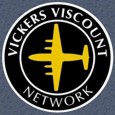
March 1956 to October 1959
Trans-Canada Air Lines (TCA)
CF-TGY - c/n 143 - a V.757 series Viscount
Canada registered
August 1954
An order was placed by Trans-Canada Air Lines (TCA) for an initial batch of seven Type 757 aircraft as a follow on from the previous Type 724 order.
This order was placed before they had received their first Type 724!
This was the second one built.
The total order for Type 757 aircraft reached thirty six in May 1957.
Production Aircraft No. 105 - the 105th production Type 700 series Viscount built,
was the 68th Viscount fuselage assembled at Hurn, Bournemouth, Hampshire, England,
and the 68th Viscount assembled at Hurn, Bournemouth, Hampshire, England.
Production Order No. F02/757. Sales Order No. F02/76B. Stock Order No. F49/22B.
21 March 1955
TCA issued technical instruction V-05.04-1/1 to apply the word 'Viscount' to the tail section in 8.5 inch high red letters edged in white at the first opportunity.
2 June 1955
TCA issued technical instruction V-31.02-2/5 to apply the word 'Viscount' to the inside of the passenger loading door in 4 inch high red letters edged in white at the first opportunity.
20 October 1955
Fuselage assembly commenced at Hurn Airport, Bournemouth, Hampshire, England.
11 December 1955
Fuselage to Erecting Shop 'E' at Hurn Airport, Bournemouth, Hampshire, England.
22 March 1956
First flight from Hurn Airport, Bournemouth, Hampshire, England.
It was fitted with Rolls-Royce Dart RDa3 Mark 506 engines.
28 March 1956
Aircraft passed off by TCA inspectors as completed and ready for delivery.
The word 'Viscount' had not been added to the tail at this stage.
29 March 1956
Departed from Hurn Airport, Bournemouth, Hampshire, England on delivery to Trans-Canada Air Lines (TCA) with fleet number '617'.
After arriving at Prestwick Airport, Ayrshire, Scotland to refuel it departed to Keflavik Airport, Iceland (743 nautical miles).
Departed from Keflavik Airport, Iceland to Bluie West One (BW1) Airfield, Narsarsuaq, Southern Greenland (804 nautical miles).
BW1 was built during WWII to assist the transfer of military aircraft from North America to Europe and was opened in January 1942.
It then departed to Goose Bay Airport, Newfoundland & Labrador, Canada (672 nautical miles).
Arrived at Dorval International Airport, Montreal, Province of Quebec, Canada (810 nautical miles).
This was the first TCA Viscount to be delivered on the same day as it departed from the UK!
The cabin seating was installed in Canada, as the seats used by TCA were of American manufacture.
The cabin was fitted out with 40 seats which was a reduction from the original 48 seat specification and provided more leg room.
This was heavily marketed and resulted in a high load factor compared to the 18 seat Douglas DC-3 that it replaced on some routes.
July 1956
Cabin interior changed to a two class 44 seat arrangement.
10 July 1957
TCA issued instructions that all Viscounts would be repainted in a 'White Top' livery when a suitable maintenance period became available.
3 October 1959
Damaged beyond economic repair after hitting an embankment on a night approach to Malton Airport, Toronto, Ontario, Canada during heavy rain.
During an ILS back-beam approach to Malton Airport, Toronto, Ontario, Canada, the aircraft descended below the glidepath and collided with a grass embankment that surrounded a water reservoir, which was 3,400 feet short of the runway threshold. This severely damaged the engines, propellers and undercarriage which started to break away from the aircraft.
The aircraft became airborne again and the pilots managed to glide it down on its belly, breaking its back, which was now within the airport boundary.
At the time of the accident the weather consisted of a thunder storm with heavy rain and reduced visibility.
After the accident most of the passengers set off through the wet mud to the nearest store to raise the alarm as the airport tower had lost radio contact.
The passengers praised former WWII Handley Page Halifax decorated bomber pilot Captain Harry Bell for saving their lives by bringing the aircraft down on its belly. Not sure he had much choice!
There were some injuries reported to 3 of the passengers and 2 crew members amongst the 34 passengers and 4 crew on board.
Captain Harry Bell sustained a back injury during the crash landing and had to be helped from the cockpit by John, the First Officer.
TCA compensated passengers by paying their dry cleaning bills but sadly relieved Harry of his command and employment.
PROBABLE CAUSE: The verdict at the time was a misjudged approach by the flight crew but the weather conditions almost certainly resulted in what is now known as a microburst which is a sudden localised column of sinking air. This allowed the aircraft to suddenly drop and strike the embankment during the final approach. There was no means of climbing away from this predicament.
Total time 9,404 hours and 7,800 total landings.
Remains recovered and all useful parts removed. There are airworthiness regulations on how parts can be used after being subjected to a crash condition.
early 1960s
As a child Robert W Arnold remembers seeing an ex TCA Viscount fuselage lying on the ground adjacent to Dublin Avenue near the Border Street junction in Winnipeg, Manitoba, Canada.
No other TCA Viscount fits the time-frame, so it has been added here. Did anyone take a photo of it in this location?
|



